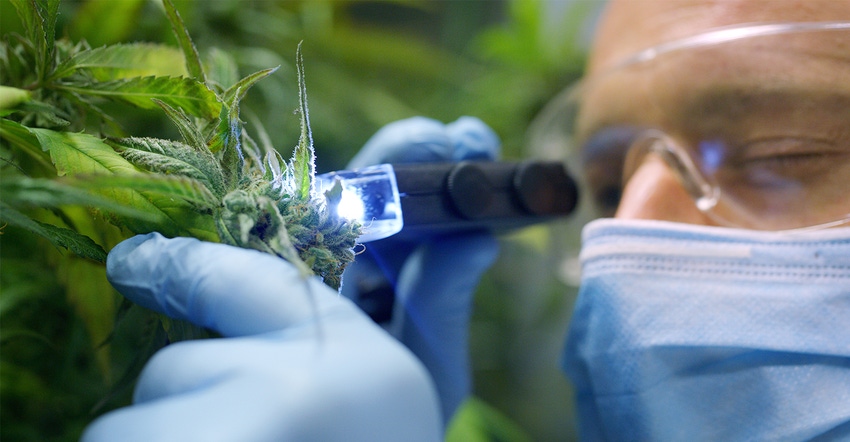CBD testing: Being certain with uncertainty
With new regulations for the testing of hemp and CBD, product suppliers must consider how a lab deals with variation and uncertainty before picking a partner

The most pressing issue in CBD testing has little to do with the CBD molecule itself, and is more about THC and its uncertainty of measurement.
If there was ever a case study about why measurement uncertainty is important for both regulators and business, this is it.
Some background first. In 2019, around 15% of hemp grown for its CBD content was considered illegal, containing more than 0.3% THC. Tens of thousands of pounds were ordered destroyed, sold for pennies, or left to sit and rot. Like in sports, it’s never the blowouts that hurt, but the close games. And failed THC results in hemp can be the closest game imaginable.
The giant pain for farmers and suppliers is most of the “hot” samples tested astonishingly close to 0.3%, and generally less than 1%. This material would never get anyone stoned and posed no threat to anyone as marijuana.
As a side note, 0.3% is not based on any reasoned thinking. In 1976, the botanists Small and Cronquist referenced 0.3% THC as a rule of thumb for the upper leaves and parts in fiber-type plants containing lower amounts of cannabinoids, with tall stalks, large leaf clusters and small flowers. Scientifically speaking, this is completely different than today’s hemp plant – the large-flowered, bushy type grown today for CBD.
From a quality control point of view, having a pass/fail limit of 0.3% of anything naturally present at around that amount, the difference between legal and illegal, is maddening and confounding. At the very least, shouldn’t it be 0.3%, plus or minus some number, that’s the variance of the measurement?
The truth is all measurements have some amount of imprecision or uncertainty. Uncertainty of numerical value measurements is usually reported as variance, or the standard deviation squared. On a measuring tape, the uncertainty is typically the smallest marked unit – one-sixteenth of an inch, for example. In chemical analysis, measuring uncertainty is something that requires validation, or testing done in multiple ways, to rule out sources of imprecision or inaccuracy.
When combined, all sources of error can and do spell the difference between pass and fail for any sample that naturally contains amounts near the limit.
Labs are the main source of testing uncertainty, as to be expected. Here are some ways to understand the variation in lab results:
Same-day precision
When a lab injects three samples split from the same sample, the percent or portion of the average result that varies from one another represents instrument variation. We are looking for the lab to report no more than a 5% difference (as % RSD [relative standard deviation]) in consecutive runs of the same sample.
Multi-day precision
When a lab separately prepares and tests the same sample on two different days with different technicians, this represents “intermediate precision,” and is generally a higher number than repeatability. We are looking for an intermediate precision among different-day values of no more than 10%.
Another way to measure precision is with reproducibility, or the variance in results across multiple labs of the same samples. This variance is always a small amount higher than the within-lab variance.
Does your testing lab understand and acknowledge their measurement uncertainty?
If your lab is high-throughput, and really worth its weight, it should be able to show data for its measurement of variance. This includes validation reports, ongoing calibrations, control charts, proficiency testing and duplicate results for control samples that support continued validity of results over time.
Sadly, some labs are known to cut corners on calibration and control samples. These labs are also the ones that tend to report incorrect results more frequently.
It’s not all the labs’ fault. On the farm and supplier level, you have a lot of potential causes for uncertainty that are difficult to control or measure, which include the following:
Sampling
The same plant can produce samples that have different compositions of cannabinoids. In a period of days during late summer, a plant makes its conversion from legal to hot. This moment in time is when the plant evolves from an innocuous source of fiber into something apparently evil and sinister.
And which flowering parts on the plant should be sampled? The large bud on top, versus the small bud on the lower inner side of the plant? There’s likely to be different cannabinoids in the same top eight inches of different stalks on the same plant. Which part gets cherry-picked: the tallest plant with the tallest, largest buds; or the lower part of the plant on the smallest plant in the field; or somewhere in between?
Moisture and curing
THC increases in samples as they dry and cure. Depending on how dried or old the sample is when it’s tested, the THC amount will change in the same sample. If a freshly harvested sample is left in a paper bag for a weekend, it can start to rot and its cannabinoids will change. If a sample is very old, it has likely degraded over time.
Regulators and industry still are working to determine the criteria for standardizing test methods and results and limiting sources of variance by creating a path for recognized official methods of analysis for cannabinoids. In the meantime, if you are a CBD supplier that has thoughtful SOPs (standard operating procedures) and works to ensure all samples are tested appropriately, in a representative and appropriate way, you’re on the right track.
To read related content, check out the “Hemp/CBD: Market evolution” digital magazine.
Blake Ebersole has led several botanical quality initiatives and formed collaborations with dozens of universities and research centers. As president of NaturPro Scientific, Ebersole established quality compliance and product development services for supplements and ingredients such as ID Verified™. Follow him on Twitter at @NaturalBlake.
About the Author(s)
You May Also Like






.png?width=800&auto=webp&quality=80&disable=upscale)